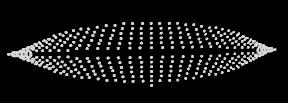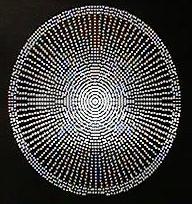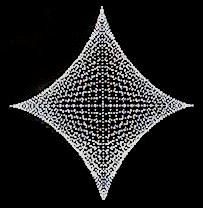It has been said that microscopists share a limited number of interests beyond their field and that prominent among these are mathematics and music. With the latest developments in the study of inheritance and gene technology, perhaps it’s a good idea to take a look at those little plants over which numerous microscopists have laboured countless hours.
There are few employed in the mounting
of these fascinating objects nowadays compared with Victorian
times, but we can identify Klaus Kemp at www.diatoms.co.uk as one of the few commercial mounters in the UK
working to such a standard.
Some time ago now, although I am mainly interested in the
aesthetic and ecological aspects of diatoms, I decided to
tackle the mysteries of fractals, their occurrence in nature
and the pretty patterns that they could exhibit on the
computer. I bought a book on the subject (ref. 2) which
contained lots of computer programmes. As promised by the
distinguished author, I very soon produced a complex of
squares something like an old Islamic illuminated text. The
result impressed me immensely. It was not long before I
generated the idea that perhaps some of our most beautiful
natural patterns such as those on the diatom frustule just
might conform to some sort of mathematical order and that the
iteration, possible on a computer program might just be able
simulate these .
Of course they would not be true
fractals and nor would they be real diatoms, but it might
just be a fun project for a Christmas holiday.
The early efforts using the BBC BASIC language and then the
AMOS AMIGA BASIC language were alarmingly successful. Since
those days we are now left with home computers that are
rarely equipped with the BASIC language. Only QBASIC is
commonly available under the file “OLD MS DOS” on
the Windows 95 Companion disk, although it can be found more
commonly on WINDOWS 3.1. It is normally run on the MS DOS
MODE.
In order to draw a simple circle in the Cartesian system,
most programmers use the general formula X=SINE A and
Y=COSINE A ,when A increases from 0 to PI TIMES 2. Of course
its only a tiny circle, so a multiplier must be used. By
manipulation of the co-ordinates, ellipses, circles and other
shapes can be formed. By expanding one axis and reducing the
other in consecutive scans, a set of dots begins to unfold.
At one point a Navicula shape emerges and then a
double ellipse becomes almost the shape of Biddulphia
antedeluviana. A three dimensional format would perhaps
become very complicated, but even in this simple form there
are some interesting comparisons with real diatoms.
A. The external shape can be very similar.
B. The orientation of the dots was very similar to some species.
C. The spacing between the lines of dots is similar to some diatoms.
D. If the value of the increments ( C ) is changed from fractions of pi then asymmetrical arrays can be produced with alternating lines.
LITERATURE.
1) Barber and Haworth. Freshwater Biological Association (FBA) Publication No. 44, “The Diatom
Frustule” ISBN 0-900386-428. Gives the whole range of
shapes of the diatom.
2) Lauwerier H., Penguin, ”Fractals, Images of
Chaos”, ISBN 0-14-014411-0. A basic book of fractals.
3) Darnton. B., “Turkey, fractals and suchlike nonsense”, Balsam Post, April 1994, Issue No. 23, ISSN 0961-043X. (Balsam Post is the quarterly magazine of the Postal Microscopical Society, UK.)
Comments to the author Brian Darnton are welcomed.
PROGRAMMES AND THEIR IMAGES
If you have trouble with writing or
running the 3 programmes, send me an e-mail request and I
will send the files to you as attachments. The files will
only work on Qbasic and require translation into other basic
languages. Do try manipulating the co-ordinates and stepping
values and see what shapes and orientations you can create.
Note that the 'G loop' is only inserted to slow down
development in order to enjoy the image creation: It is not
essential. I have pared the language down to a minimum for
rapid results. The images are low resolution digital
photographs from the screen.
|
|
|
Microscopy UK Front Page
Micscape Magazine
Article Library
© Microscopy UK or their contributors.
Published in the July 2000 edition of Micscape Magazine.
Please report
any Web problems or offer general comments to the Micscape Editor,
via the contact on current Micscape Index.
Micscape is
the on-line monthly magazine of the Microscopy UK web
site at Microscopy-UK


